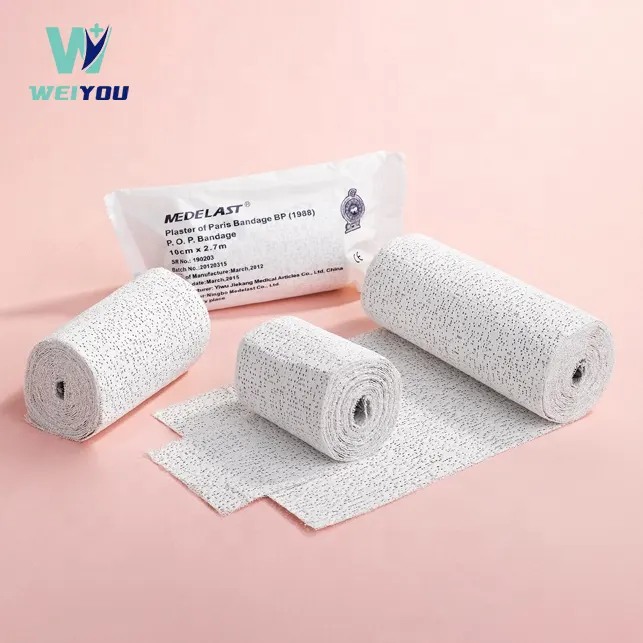- English
- Español
- Português
- русский
- Français
- 日本語
- Deutsch
- tiếng Việt
- Italiano
- Nederlands
- ภาษาไทย
- Polski
- 한국어
- Svenska
- magyar
- Malay
- বাংলা ভাষার
- Dansk
- Suomi
- हिन्दी
- Pilipino
- Türkçe
- Gaeilge
- العربية
- Indonesia
- Norsk
- تمل
- český
- ελληνικά
- український
- Javanese
- فارسی
- தமிழ்
- తెలుగు
- नेपाली
- Burmese
- български
- ລາວ
- Latine
- Қазақша
- Euskal
- Azərbaycan
- Slovenský jazyk
- Македонски
- Lietuvos
- Eesti Keel
- Română
- Slovenski
- मराठी
- Srpski језик
What are some tips for making your orthopedic bandage more comfortable to wear?
2024-10-10

What are the different types of Orthopedic Bandage?
There are various types of orthopedic bandages used in the medical industry, designed for different parts of the body. Here are a few of the different types of bandages:- Compression bandages
- Hinged knee braces
- Shoulder immobilizers
- Wrist supports
How should an Orthopedic Bandage be worn?
Proper usage of orthopedic bandages is essential to ensure comfort and an effective healing process. Here are a few tips for wearing an orthopedic bandage:- Ensure the bandage is not too tight or too loose.
- Wrap the bandage smoothly and evenly, avoiding any wrinkles or folds.
- Make sure the skin underneath is clean and dry.
- Follow the instructions given by the doctor for when and how long to wear the bandage.
What are some tips to make an Orthopedic Bandage more comfortable?
It is common for patients to feel a bit of discomfort while wearing orthopedic bandages as they are tight and restrictive. Here are a few tips to make the experience more comfortable:- Avoid wearing it too tightly.
- Layer a cotton liner underneath the bandage for added cushioning and comfort.
- Apply an ice pack to the area covered by the bandage to help reduce swelling and inflammation.
- Wear loose and comfortable clothing over the bandage, avoiding any tight or abrasive garments that may rub against the bandage.
In conclusion, orthopedic bandages are an essential part of the healing process after an injury or surgery. Proper usage and care of these bandages can make the recovery process more comfortable and lead to a speedy recovery.
Ningbo Weiyou Import & Export Co., Ltd. is a leading manufacturer of medical products, including orthopedic bandages. We are dedicated to providing high-quality products that promote the healing process and support our patients' comfort. Contact us today at dario@nbweiyou.com to learn more about our products and services.
Scientific Research Papers:
1. John P. Lubicky. (2005). Osteogenesis Imperfecta. Journal of Pediatric Orthopedics. Volume 25, Issue 4.
2. Zeng C, et al. (2015). Prevalence of knee osteoarthritis in the United States: arthritis data from the third national health and nutrition examination survey 1991-1994. Journal of Arthritis Care and Research. Volume 67, Issue 12.
3. K.-H. Fenzl. (2000). Neuro-orthopaedics: Past, present, and future. The Journal of Spinal Cord Medicine. Volume 23, Issue 1.
4. E. Percy Mui, P. Leung, C. Li, D. Hung, and J. Love. (2016). The Impact of Orthopedic Implant Design on Periprosthetic Stress-Shielding: A Systematic Review. The Journal of Arthroplasty. Volume 31, Issue 4.
5. Chun-Chieh Wu, Wei-Chen Huang, Chih-Hsiang Chang, Kuan-Jung Chen, Chih-Chien Hu. (2020). Effects of leap training on lower extremity joint kinetics during landings. Journal of Human Kinetics. Volume 71, Issue 1.
6. Kasper Fogh, Christina Tsitsilonis, Lars Engebretsen, and Jens Aaboe. (2013). The Effect of Early Initiated Therapeutic Exercises on Postoperative Recovery of Tibial Plateau Fractures. Orthopedic Journal of Sports Medicine. Volume 1, Issue 1.
7. Johanna S. van der Leeuw, Martin J. Heetveld, Esther M.M. van Lieshout, Mark van de Sande, Duncan E Meuffels and Reinoud W. Brouwer. (2021). Patient-reported Outcomes after Surgical Treatment for High-energy Tibial Plateau Fracture. Journal of Clinical Orthopedics and Trauma. Volume 16, Pages 116-120.
8. Shun-Wei Shen, I-Chun Lai, Chien-Chih Hong, and Jia-Hui Lin. (2019). Orthopedic Surgeons Show a Higher Burnout Rate Than Other Physicians in Taiwan: A National Survey. The Journal of Bone and Joint Surgery. Volume 101, Issue 17.
9. Matteo Romagnoli, Edoardo Monaco, Francesco Maria Mezzadri, Massimo Innocenti. (2017). Overview of the European Experience With Patient-Specific Orthopedic Implants From the Hospital Institution Perspective. The Journal of Arthroplasty. Volume 32, Issue 3.
10. Gregory D. Myer, Adam W. Kiefer, Kevin R. Ford, Jane Khoury, Timothy E. Hewett. (2019). Longitudinal Assessment of Noncontact Anterior Cruciate Ligament Injury Risk Factors During Maturation in a Female Athlete: From10 to 17 Years of Age. The Journal of Orthopaedic and Sports Physical Therapy. Volume 49, Issue 4.



